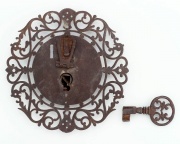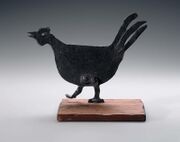Wrought iron
Description
A malleable form of metallic Iron. Wrought iron is nearly pure iron with less than 1 percent Carbon and about 2.5 percent Slag. It was the only type of iron produced from iron ore until Cast iron was developed in China in the 3rd century BCE. Wrought iron continued to be the only iron made in Europe and the Middle East until the medieval period. For production, the ore was smelted, then the resultant iron bloom was hammered, stretched, and annealed to remove impurities. It was then easily worked by forging, bending, rolling, and drawing. Modern wrought iron is industrially made from refined cast iron. Over the years, wrought iron has been used for many decorative items (hand-crafted church screens and body armor) as well as architectural components (hardware, roof sheeting, pipes, grilles, railings, and fences). Completed in 1889, the Eiffel Tower not only became the tallest human-made structure in the world, but it also became, and remains, the most famous wrought iron construction. Mild Steel is often used now for imitation wrought iron gates because it can be hot-dip galvanized to prevent corrosion.
| Chemical composition comparison of cast iron, plain carbon steel, and wrought iron (values in wt.%) | ||||||
|---|---|---|---|---|---|---|
| Material | Iron | Carbon | Manganese | Sulfur | Phosphorus | Silicon |
| Cast iron | 91–94 | 2.0–4.5 | 0.5–2.5 | 0.018–0.1 | 0.03–0.1 | 1.0-3.0 |
| Carbon steel | 98.1–99.5 | 0.07–1.3 | 0.3–1.0 | 0.02–0.06 | 0.002–0.1 | 0.005–0.5 |
| Wrought iron | 99–99.8 | 0.05–0.25 | 0.01–0.1 | 0.02–0.1 | 0.05–0.2 | 0.02–0.2 |
Synonyms and Related Terms
weld iron; puddle steel; puddled iron, charcoal iron; fer forgé (Fr.); Schmiedeeisen (Deut.); smeedijzer (Ned.); ferro forjado (Port.)
Resources and Citations
- Jonathan Taylor, Steve Suff, "Wrought Ironwork" Building Conservation Directory 2000: Link
- Wrought Iron Advisory Center: Link
- R. J. Gettens, G.L. Stout, Painting Materials, A Short Encyclopaedia, Dover Publications, New York, 1966
- G.S.Brady, Materials Handbook, McGraw-Hill Book Co., New York, 1971 Comment: p. 882
- David C. Scott, Metallography and Microstructure of Ancient and Historic Metals, The Getty Conservation Institute, Los Angeles, 1991
- Dictionary of Building Preservation, Ward Bucher, ed., John Wiley & Sons, Inc., New York City, 1996
- Encyclopedia Britannica, http://www.britannica.com Comment: "wrought iron" [Accessed October 18, 2001].
- The Dictionary of Art, Grove's Dictionaries Inc., New York, 1996 Comment: "Iron and Steel"
- Handbook on Wrought Iron Conservation from Chriss Topp Co. at http://www.christopp.co.uk/pdfs/CToppStudentsConservation.pdf
- Steve Suff: Submitted information
- Wikipedia: Wrought iron Accessed March 2025
- Wikipedia: Eiffel Tower Accessed March 2025

